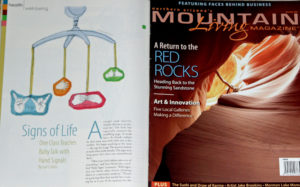![]() November 2008
November 2008
 A couple took their fourteen-month old son to an animal fair where the little boy especially enjoyed the snuffling pigs. A week later, the family walked by that same area with their son in his stroller. He began pushing at his nose—the sign for a pig. The parents looked at each with wonder. The pigs were long gone, but their son remembered them.
A couple took their fourteen-month old son to an animal fair where the little boy especially enjoyed the snuffling pigs. A week later, the family walked by that same area with their son in his stroller. He began pushing at his nose—the sign for a pig. The parents looked at each with wonder. The pigs were long gone, but their son remembered them.
“Observant little babies take note of everything,” said Tami Nicholson, a certified Baby Signs instructor. “With signs, you can know what they’re thinking about at a particular moment.” There’s no guessing what that tearful face is asking for at 2 a.m. If she squeezes her fist—simulating udder action—she wants milk.Nicholson yearned to have this kind of connection with her first child, Kendall. She bought the book, Baby Signs: How to Talk with Your Baby Before Your Baby Can Talk by doctors Linda Acredolo and Susan Goodwyn. Nicholson was impressed with the bonding possible through clear, simple messages. When she couldn’t find a class in Flagstaff three years ago, became an instructor. She teaches other parents how to interpret their baby’s tears or tantrums.
It was the desire of Acredolo’s own one-year-old daughter to communicate with her that led to the discovery and research for Baby Signs in the mid-1980’s. Her little one’s sniff-sniff to indicate flowers started a movement. Most babies self-create signals, in their desperation or delight, to tell us what their undeveloped vocal tract cannot.
“Babies sign whether or not you teach them,” said Nicholson. “Think of it—every baby learns to wave bye-bye.” By employing the basics of American Sign Language plus a few baby-fashioned gestures, parents can talk to their child. And their child can sign back.
Many parents wonder whether signing slows down a baby’s language skills. This became a major concern for the founders of Baby Sign. With the help of a National Institute of Health grant, they compared the verbal development of signing and non-signing babies within the same communities. In multiple tests, the signing babies actually talked sooner. The ability to express themselves encouraged these children to explore the words beyond their signs, the way crawling leads to walking.
It’s easy to see the benefits of knowing, instead of guessing, a child’s needs or interests. It reduces irritation and creates trust, enriches the bond between baby and parents and encourages positive emotional development. In addition, it jumpstarts your child’s means to actual speech. But how does it work?
Nicholson recommends beginning to sign with babies at six to nine months of age when hand coordination is sufficient, though it’s not too late to start with toddlers who have a rudimentary word base. “I had a class of babies from six- to 14-months old, without any signing background. The six-month old began to sign by the end of the class, and the 14-month old had about 15 signs.” It can take two weeks or two months, but there is a light bulb moment that quickly builds understanding and vocabulary.
Parents sign and speak simultaneously when teaching their babies. “Start with meal signs or things that interest your child,” Nicholson suggested. Babies are also fascinated by dogs. Parents can pat their sides, pant and say, “Dog.” That’s all there is to it. That and plenty of repetition. Board books are perfect for practicing.
Catch the child’s attention and keep it fun and short. Quiet, thoughtful babies like Nicholson’s first daughter tend to respond earlier. “The more active the baby, the longer it’s going to take the baby to sign,” she said from experience with her second daughter. Sydney finally grasped the advantages of signing to Mom at 14 months. Fortunately Kendall, three years old now, coaxes her sister to learn more.
Kristin Bratland took Nicholson’s “Sign, Sing & Play” class with her son, Konner, when he was six months old. She kept playing at signs with him, and at one year, Konner responded with his first sign. In a month, he’d learned 30. Bratland said, “Konner has a wonderful sense of self confidence that as a mom, I’m so thankful to see. Now I understand why it is easy for little ones to get so frustrated; they have a lot to say but no means to say it. Konner already he knows so much at 16 months old. But even better is that I can easily give him what he needs because he can tell me. Isn’t this what all moms want to be able to do?”
We talk to our babies anyway as they sit propped in a baby seat on the kitchen counter while we chop vegetables. It is amazing to consider that as they wave their chubby hands, they may be wondering about the music playing, the dog barking nearby or the kisses we blow to them. Why not harness our insatiable desire to communicate while offering our little ones a way to point out the incredible wonder they notice around them?
As a storm sends drops splattering against the window, Nicholson’s daughter, Kendall can turn to her baby sister and reassure Sydney. With arms fluttering down and fingers wiggling, she can smile and say, “Rain.” NAMLM Gail G. Collins
Learn more about Baby Signs at www.babysigns.com or contact Tami Nicholson at [email protected] Six-week Sign, Sing and Play Classes cost $99 and include: DVD, drool-proof reference guide, plus CD and songbook, stuffed into a fuzzy, baby-sized backpack. To help parents decide, Nicholson offers a free informational night at Flagstaff Medical Center.
